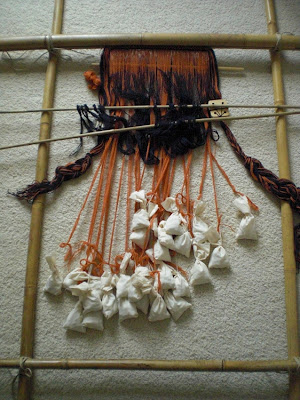Since February I am at the Centre for Textile Research (CTR) in Copenhagen and started working on my project Periphron Penelopeia. In my project I intended to do some practical weaving but this is not a task that fits into the office
space of a university. So I went home to Germany for one week. There I have a room to work in and there I set up a loom that is meant
just for doing experiments on some
technical aspects of weaving on a warp-weighted loom. It is not a
reconstruction of the materiality but of the techno-logic of weaving in
antiquity.
In summertime you can buy cheap stuff for the
garden - or for an experimental loom. In the first picture you see a lot of Bamboo sticks in
different diameters to be used as posts, heddle rods or just sticks for picking
up the warp threads when patterning the fabric. The only stick that should be
really straight is the one that will carry the headband of the fabric. Here
this tablet-woven band is already fixed to this stick that will be inserted
into the hollow bamboo rod on the top. See details in the second and third picture.
In the end the
weights are knotted to groups of warp threads. These are ordered according to
the distribution of threads on four shafts for a double tabby weave (fabric
with dark and light side). The small cotton bags used as weights are each filled with ca. 100g
gravel stones.
The tablet
weaving will go on at both sides of the weave. I did not really set up the
loom, because now I have to decide on the patterns to weave and look through
all the marvellous books of CTR and through my collection of textile patterns
from vase paintings. Then I will decide what to weave when I go back to my
little weaving workshop in Germany in August.








